The Nile River, known as the Gift of the Nile, has been Egypt’s essential lifeline for thousands of years. Its predictable annual floods enriched the soil, enabling agriculture and the rise of a powerful civilization. Spiritually, it symbolized life, death, and rebirth, deeply tied to deities like Ra, Osiris, and Isis. The Nile shaped Egypt’s geography, supported trade and transport, inspired sacred rituals, and influenced the calendar. Over time, Egyptians developed irrigation systems and built structures like the Aswan High Dam to harness its power. Today, the Nile remains vital to agriculture, energy, tourism, and international cooperation, embodying Egypt’s enduring legacy.

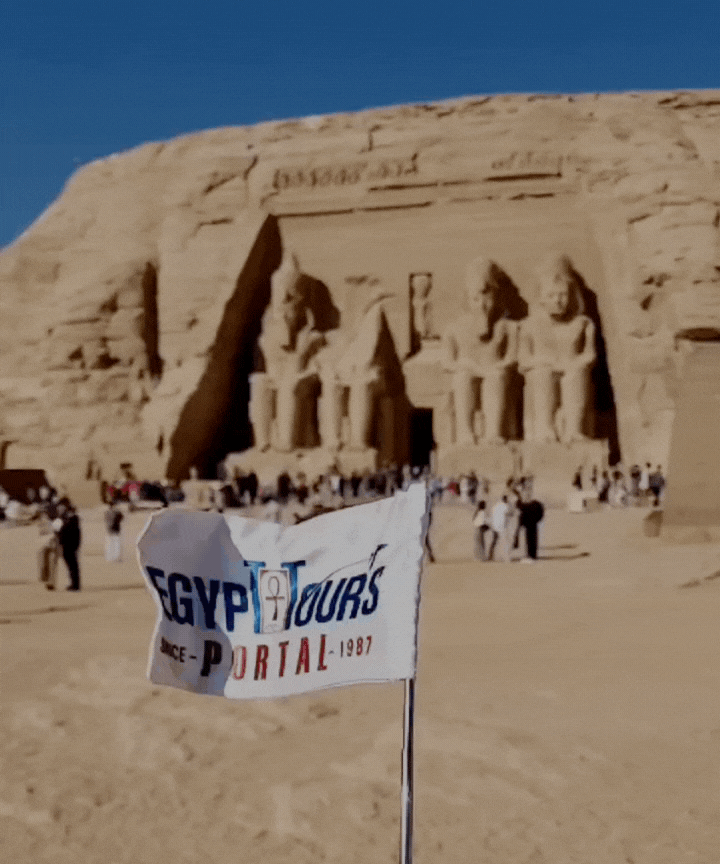
Egypt was given the ultimate gift, “The Nile River” from the heavens, which brought life that nurtured the nation's past, present, and future. It gave rise to the civilization of Egypt that walked hand in hand with the waves of time, creating prosperity and wealth on the banks of the Nile River of Egypt. The life-giving waters of the Nile River were the source of the nation's agriculture, culture, economy, and history, thus transforming Egypt into a symbol of enduring greatness and vitality.
The Nile River gifted Egypt with infinite wealth and unlimited enlightenment that was able to start a chain reaction which resulted in the creation of not only the Egyptian civilization but also several ancient Civilizations that crafted the foundation, the fabric of our societies, and everything we hold dear in this world.
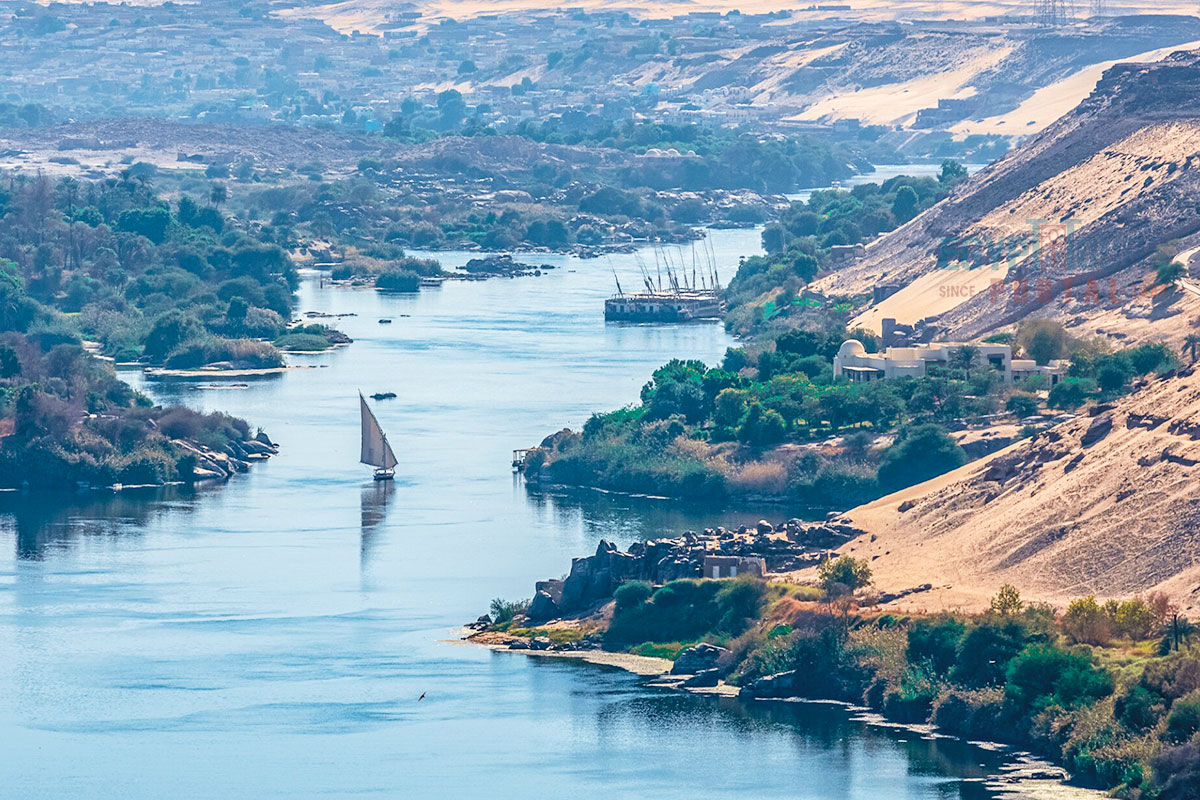
Across the desert terrain of Africa, a blessed gift was given to Egypt in the shape of the Nile River, which would explain why the Greek historian Herodotus nicknamed the region “ The Gift of the Nile River” as it was the key to the survival and flourishing of Egypt across the ages.
The annual flooding of the Nile River not only filled with water but also deposited silt and sediment, which fertilized the land and provided Egypt with an annual cycle of three crops. The Nile River offered the ultimate protection from any kind of foreign invasion, as Egypt was surrounded by harsh desert, but Egypt was given a source of life that transformed Egypt into a refined and advanced society.
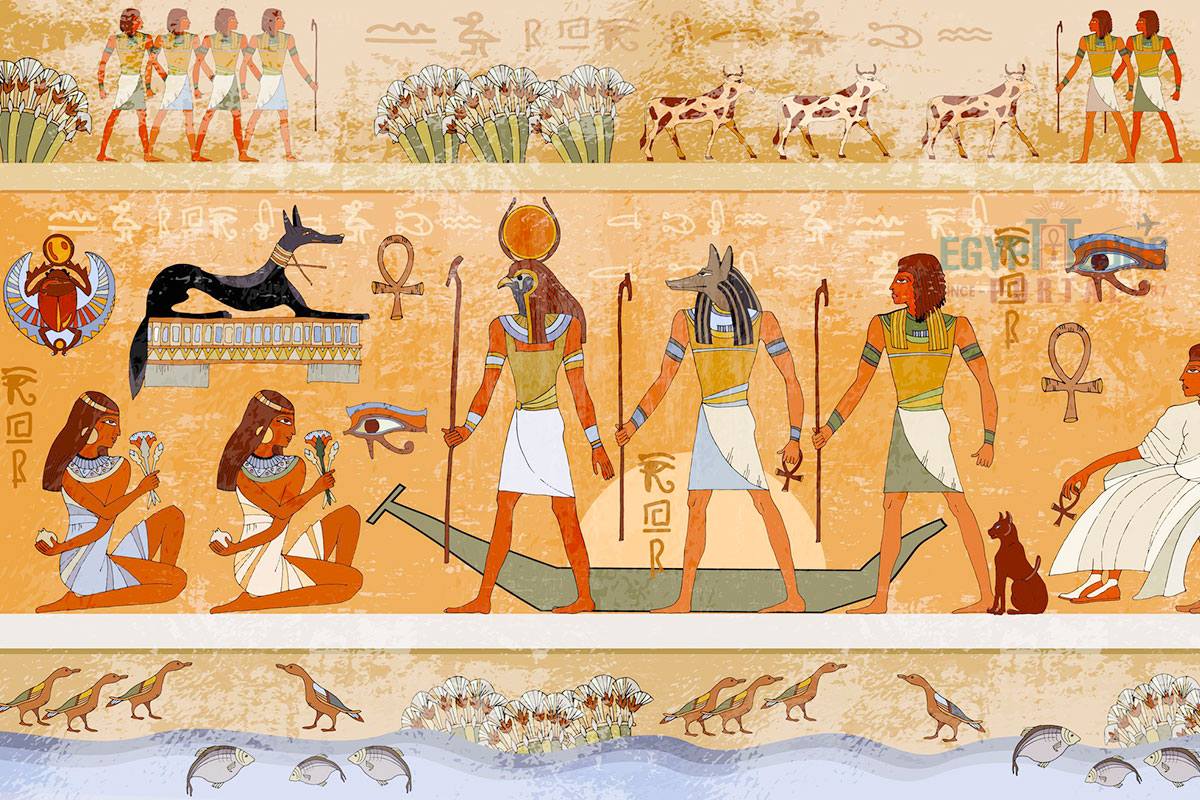
The Nile River for many ages has held immense significance for Egypt when it came to its historical and mythological importance, which became deeply ingrained in the culture of the region. The ancient Greeks, notably the historian Herodotus, recognized the Nile as the lifeblood of Egypt, famously stating that "Egypt is the gift of the Nile for many reasonable factors. The Nile River was seen as a portal from life to death and then the afterlife.
The eastern direction was perceived as a realm of emergence and development, while the western direction held the connotation of passing into the realm of the deceased. This perspective stemmed from the myth of Ra, the Sun god, who experienced a cycle of birth, demise, and revival daily while traversing the heavens. Consequently, all burial sites were positioned to the west of the Nile, reflecting the Egyptian belief that to attain the afterlife, one needed to be interred on the side representing the concept of death.
Myths and beliefs surrounding the Nile have varied, as it was considered a divine gift, and its floods were linked to the gods' control. The ram god Khnum, the lord of the water, was depicted as a ram-headed deity who was believed to bring prosperity and fertility to the riverbanks, creating life from the silt left by the floods. Hapi of the Nile River was a god embodying both male and female qualities, controlling the Nile's floods, and ensuring fertility and happiness.
The Nile's floods were synchronized with celestial events, such as the appearance of the brightest star, Sirius, marking the beginning of a new Egyptian year, which was the reason behind the creation of the ancient Egyptian Calendar, which depended mainly on the Nile Flood.
The river's levels influenced daily life, and the Egyptian calendar was divided into three seasons based on the Nile's behavior: flood, agriculture, and harvest. The Egyptian calendar was divided into three seasons: Akhet (Inundation), Peret (Growth), and Shemu (Harvest). The Nile flood came in the Akhet season, and the first sign of flooding was observed in Aswan in June.
The illustrious deity Ra held the esteemed titles of both the supreme father and ruling monarch among the gods of ancient Egypt, in addition to his role as the radiant sun god. Each day, he embarked on a celestial voyage along the heavenly Nile, bestowing light upon the earth. As the evening descended, Ra transitioned to the vessel known as Mesektet, traversing the depths of the underworld. Conquering the serpent Apop at dawn, Ra would once more grace the horizon with his luminous presence. This profound cycle of Ra's journey symbolized the intricate interplay between the subterranean and celestial Nile, embodying the eternal dance of day and night meticulously observed by the ancient Egyptians.
The Nile River played a pivotal role in the myth of Isis and Osiris, who was a significant deity that played a role in Nile-related myths. He was murdered by his brother Set, and his body parts were scattered in the Nile. His wife, Isis, reassembled his body, revived him, and gave birth to Horus, who eventually avenged Osiris by killing Set. This myth connected Osiris's resurrection with the Nile's floods and decline.
Nile animals, such as crocodiles and hippos, also held symbolic importance. They were revered for protection against threats and evil. The crocodile god Sobek was worshiped in Fayoum and Kom Ombo, while certain fish and birds were seen as symbols of abundance and resurrection.
Discover the incredible mythology of Egypt, which was heavily affected by the Nile River
Read More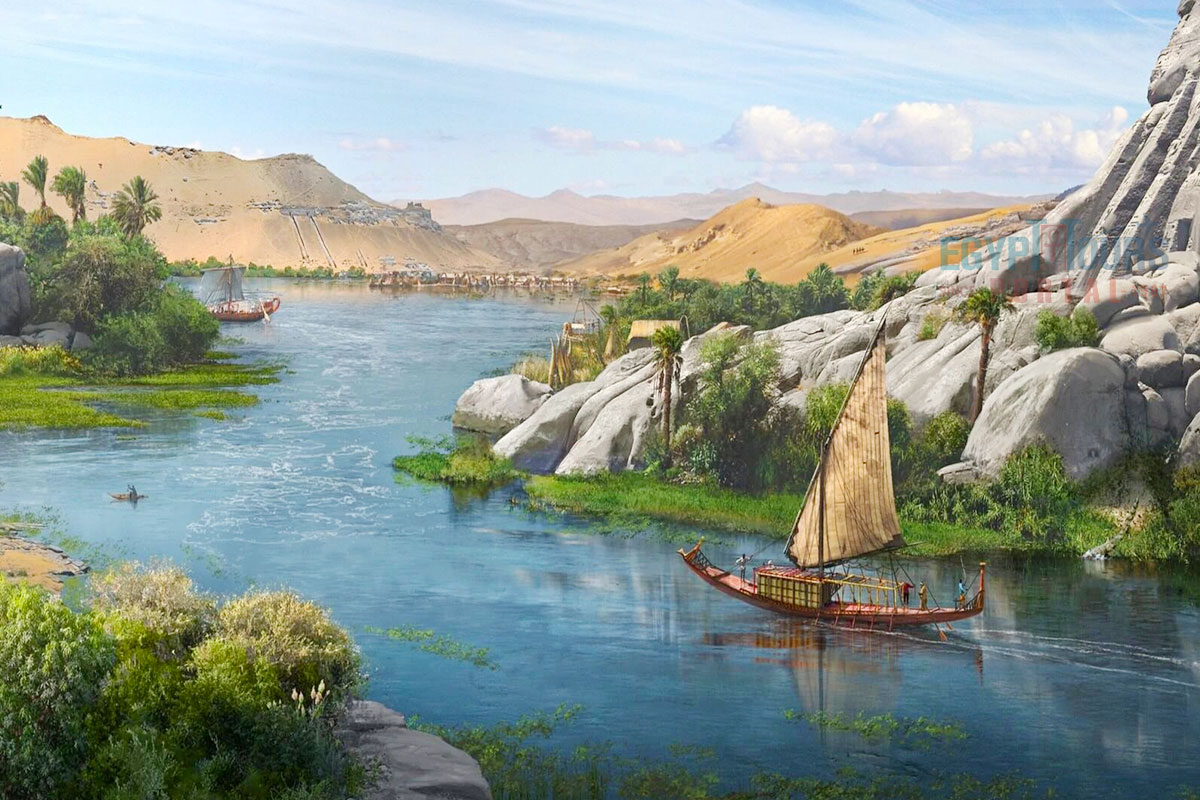
The Nile's history can be divided into several phases, including the Upper Miocenian Eonile, Upper Pliocenian Paleonile, Proto-Nile, Pre-Nile, and Neo-Nile. Over millions of years, the Nile's path shifted, creating canyons and valleys. During the Mediterranean sea's Messinian salinity crisis, the Nile cut deeply into the earth, forming a canyon later filled with sediment. The Nile has played a crucial role in Egypt's civilization since ancient times, with cities and communities thriving along its northern parts.
Initially, the Nile flowed westward into what is now Libya before changing its course due to rising sea levels. This alteration also contributed to the formation of the Sahara Desert around 3400 BCE. The Ancient Egyptians perceived the annual floods as the arrival of their deity. The earliest Egyptian communities toiled in the inundated areas, pioneering basin irrigation approximately seven millennia in the past.
These basins were intentionally flooded, sealed for a span of forty-five days to allow the soil to become saturated and silt to settle. Subsequently, the enriched soil was redirected to other sections of the fields before ultimately being returned to the Nile.
Modern exploration of the Nile basin began in the 19th century with expeditions under Ottoman rule and the British Empire later on. Isma'il Pasha, in 1873, oversaw the construction of the Ibrahimiya Canal, a project aimed at expanding consistent irrigation. The Nile has been essential for transportation and sustenance for Egyptians, allowing them to inhabit otherwise harsh regions. However, the construction of the Aswan Dam in 1970 disrupted traditional farming practices by controlling floods.
The Nile's flow is also interrupted by natural obstacles like the Cataracts and the Sudd swamp. Prominent cities along the Nile include Aswan, Luxor, and the Giza-Cairo area, where Tourists often explore the river, particularly the section between Luxor and Aswan by a magical Nile Cruise trip. The construction of the Aswan High Dam in the 1950s posed a threat to historic sites like Abu Simbel temples, leading to an extensive UNESCO effort to relocate the temple.
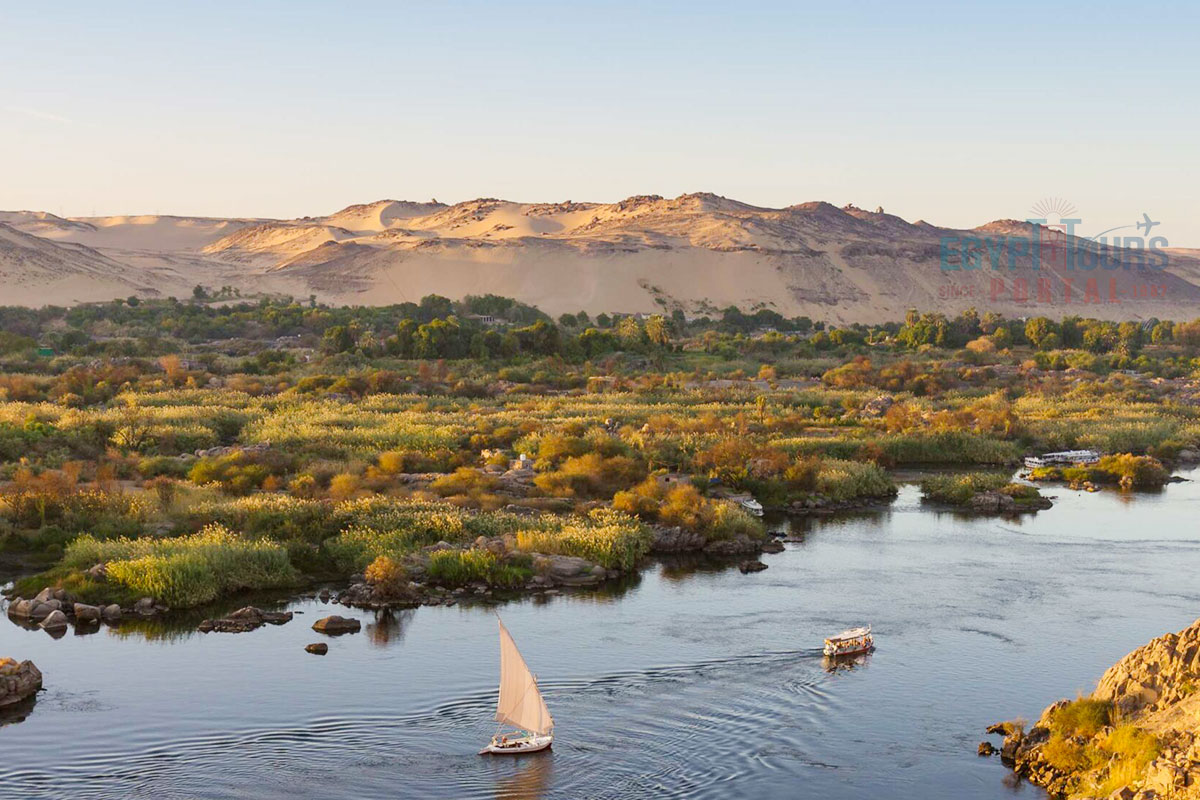
The inundation of the River Nile constitutes a vital natural rhythm that has been revered in Egyptian culture since antiquity. This annual phenomenon, akin to a festive occasion, commences on August 15 and endures for a fortnight. Ancient Egyptian tradition held that the river's inundation stemmed from the tears shed by Isis in mourning for her departed spouse, Osiris.
This cyclic flooding transpires as a result of the monsoons prevailing from May to August, engendering substantial precipitation in the lofty Ethiopian highlands, whose zenith towers at 14,928 feet. The Atbarah River and the Blue Nile channel a considerable portion of these rainwaters into the Nile, while a lesser volume courses through the White Nile and the Sobat before merging with the great river.
The ancients lacked comprehension of these intricate mechanisms, their insights limited to the observation of the Nile's periodic deluges. Accurate predictions of flood levels and onset dates could only be approximated by relaying measurements from the Aswan gauge downstream to Lower Egypt.
The comprehensive discharge and extent of inundation, however, remained elusive. The Egyptian calendar delineated three distinct seasons: Shemu (Harvest), Peret (Growth), and Akhet (Inundation), with the latter season coinciding with the Nile's flooding. Initial indications of the swelling waters became discernible around June, manifesting initially in Aswan.
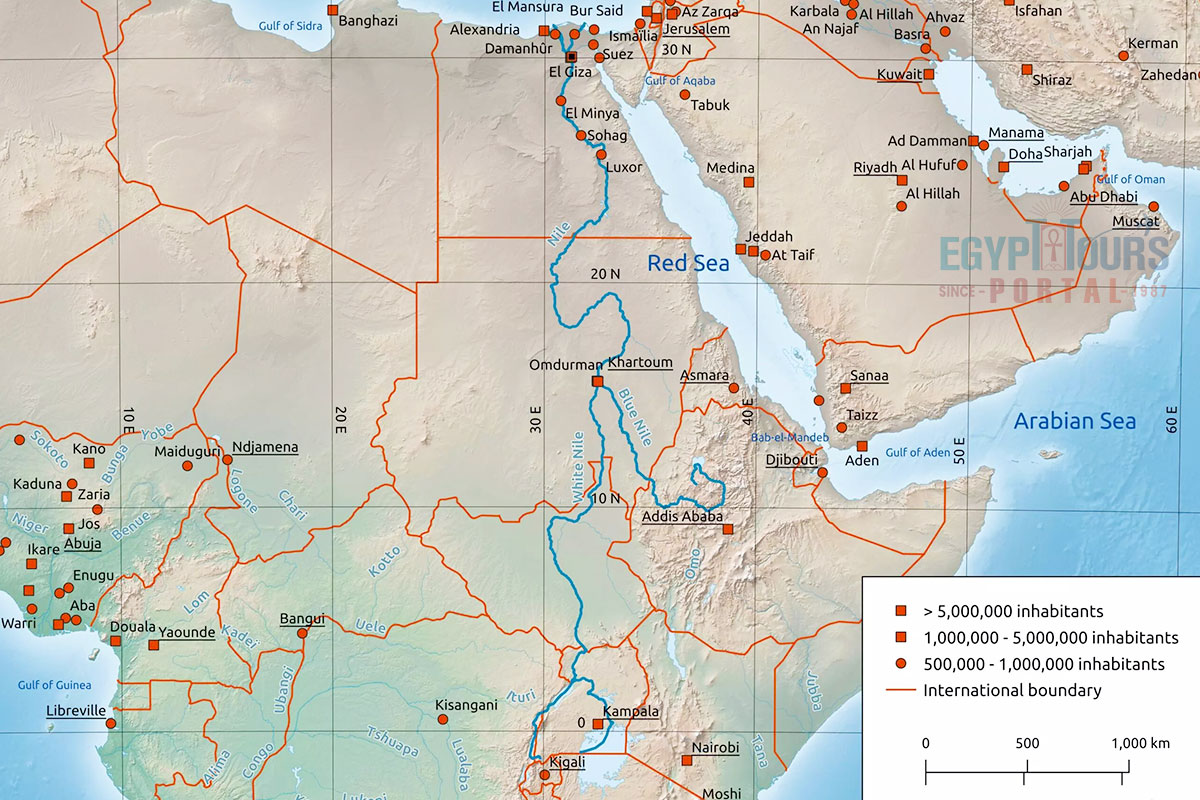
The Nile River has been the lifeblood of Egypt for centuries that giving rise to the whole civilization of Egypt with all its glory. Originating from the East African Plateau and intricately linked to the waters of the Kagera, the Nile River has gained renown for its association with Lake Victoria, where it finds its initial source. This connection elucidates the symbolic representation of the Nile, often depicted as a deity with a shrouded head.
Meandering below the Equator, the Nile River embarks on a remarkable journey northward, ultimately culminating in its embrace by the Mediterranean Sea. This monumental river stretches across an impressive expanse of 4,132 miles and encompasses a vast drainage area spanning 1,293,000 square miles. Thus, the Nile holds the distinction of once being recognized as the world's longest river, though it now stands as the second longest, surpassed by the Amazon.
The Nile's composition is a result of two major tributaries: the Blue Nile and the White Nile. Emerging from its inception at Lake Victoria in Tanzania, the White Nile gracefully flows northward until its convergence with the Blue Nile, originating from Ethiopia, an event that takes place in Khartoum, Sudan.
A momentous split occurs as the Nile divides itself into two distinct distributaries, the Rosetta Branch to the west and the Damietta to the east. This notable division gives rise to the renowned Nile Delta. Eventually, the river makes its way through Northern Egypt, traversing its length until it eventually finds its terminus at the Mediterranean Sea, near the city of Alexandria.
It is worth mentioning that the Nile River provided the necessary resources and conditions for the formation and sustenance of the ancient Egyptian civilization that made it stand the test of time. Its predictable flooding allowed for stable agriculture, leading to surplus food production and supporting the growth of cities and communities along its banks.
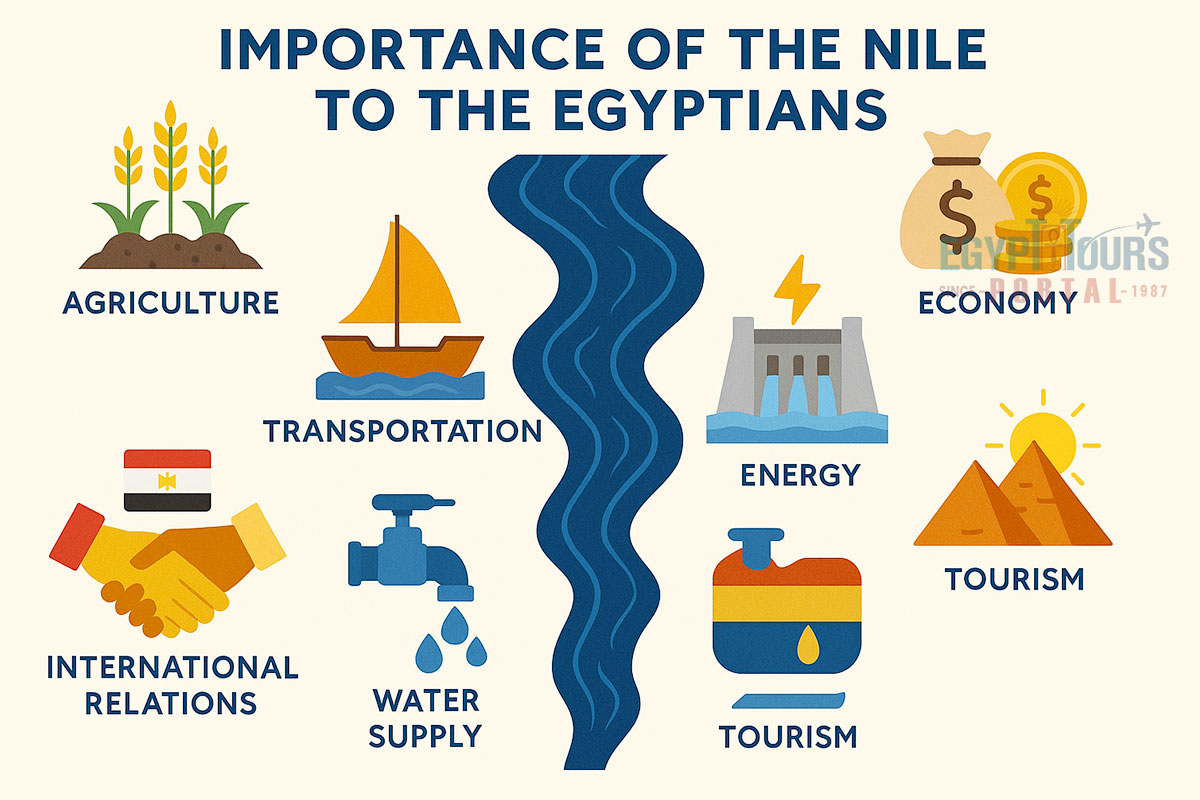
The importance of the Nile River to Egypt cannot be quantified, as in addition to serving as Egypt's primary water source, it also shapes our existence in every shape and form, plus operates as a conduit to various global regions that all people from all races and cultures.
The Nile's annual flood facilitated agriculture by depositing nutrient-rich silt onto the floodplains, ensuring abundant harvests. Ancient Egyptian civilization was supported by harnessing the Nile's cyclical flooding patterns to support their agricultural practices and grow all the food that they needed. The predictable annual flooding in August and September enriched the floodplain and delta with fertile silt, facilitating planting in October and harvesting between March and May.
While the Nile's flooding was more stable than other rivers, both excessive and insufficient flooding could pose challenges. Staple crops included grains like barley, wheat, onions, garlic, and pulses like beans and lentils. Fruit cultivation became increasingly important, requiring advanced techniques like irrigation and propagation. Indigenous fruits like palm dates and sorghum were cultivated, and later introductions included grapes, watermelon, figs, and apples.
The river supplied a reliable source of freshwater for drinking, cooking, and hygiene. Without the Nile, sustaining life in the arid Egyptian landscape would have been significantly more challenging. To optimize the Nile's water, Egyptians developed intricate irrigation systems.
Irrigation enabled controlled agricultural practices, diverting floodwaters away from urban areas and supplying drinking water. Basin irrigation was a significant technique, involving earthen walls forming grids in flooded fields. This trapped floodwater saturates the soil for cultivation. Orchards and gardens were also established farther from the floodplains, necessitating manual irrigation and fertilization.
The Nile served as a natural highway, easing transportation and trade between different regions of Egypt. Boats and ships were crucial for moving people, goods, and building materials, fostering economic and cultural exchange. The Egyptians were highly skilled in creating boats, as seen across all the boat remains found across the ancient temples in Luxor and Abydos, plus the sun boat of Khufu, which is found in the Grand Egyptian Museum. They mastered the many routes of the Nile River as they used it as the ultimate way of transportation, and Egypt was one of the first nations in history to create a navy.
The Nile's scenic beauty, historical significance, and proximity to iconic monuments like the ancient Egyptian temples of Upper Egypt in Luxor and Aswan have attracted tourists and enthusiasts from around the world. Nile cruises remain by far the most popular way to explore Egypt, allowing travelers to witness the country's rich heritage while enjoying the tranquil river.
In the modern era, the Nile has been harnessed for energy production through hydroelectric dams like the Aswan High Dam, which was made in the 60s. This has contributed to Egypt's electricity supply and economic development to open the gate to the treasures of the industrial ages.
The Nile continues to be a vital economic asset. The fertile Nile Delta and its surrounding areas are home to thriving agriculture, while fishing in the river provides a significant source of food and income. Egyptians utilized plants for diverse purposes beyond food, such as for ancient Egyptian medicine, ancient Egyptian religious practices, and clothing production. Over 2000 plant species were found in tombs, and papyrus was a versatile resource used for boats, mats, and paper. Flax was crucial for making clothing and rope, while henna was cultivated for dye. The International trade between all the neighboring ancient civilizations was pivotal to the innovation of many cultures, which exchanged their knowledge, tales, goods, and wisdom.
The Nile River has shared waters, which have influenced diplomatic relations among the countries through which it flows, as an international silk road was made in the region, leading to discussions and agreements on water management and usage. Cooperation over the Nile's resources has been essential for regional stability and development, plus the rise of ancient civilizations.
The Nile River is undeniably the Gift of Egypt, which played a vital role in Egyptian life, mythology, and history has shaped the culture and beliefs of the region for millennia. Its multifaceted contributions to agriculture, transportation, culture, and more have cemented its place in Egyptian history, that’s why it is known across the world that Nile cruises offer a unique perspective on Egypt's cultural and natural wonders, allowing travelers on their Egypt tour to experience the legacy of this remarkable river and its profound impact on the land of Egypt in the most enriching and entertaining voyage.
Private 4 Days Cairo Tour Packages for Canadian Travelers 4 days Cairo Egypt Tour pa...
Tour Location: Cairo – Giza...
5 Days Cairo and Alexandria Tour Package For Canadian Travelers 5 days Cairo and Ale...
Tour Location: Cairo/Giza/Alexandria...
6 Days Cairo, Luxor & Aswan Tour Package For Canadian Travelers 6 days Cairo, Lu...
Tour Location: Cairo/Giza/Aswan/Luxor...
Amazing 7 Days Cairo and Hurghada Holiday for Canadian Travelers 7 Days Cairo & ...
Tour Location: Cairo – Giza – Hurgh...
The phrase "the gift of the Nile" refers to the remarkable, magical, and vital contributions of the Nile River to the ancient civilization and sustenance of ancient Egypt, which was coined by the Greek historian Herodotus. It highlights the river's role in providing essential resources and enabling the development of a prosperous and advanced society in the region.
The term "the gift of the Nile" has been used throughout history to describe Egypt's dependence on and gratitude for the heavenly Nile River's life-giving attributes. It has been associated with ancient times when Egypt's civilization first flourished along the banks of the Nile River around 3700 BCE.
The Nile River has always offered several invaluable gifts to the people of Egypt, which include the annual flooding of the Nile deposits nutrient-rich silt onto the floodplain, which creates highly fertile soil that supports agriculture and allows for bountiful harvests.
The Nile River provides a consistent and dependable source of fresh water, which is essential for drinking, irrigation, and various daily activities. The Nile River served as a natural highway for transportation and trade across the ages which facilitating the movement of people, building materials, goods, and ideas between different sectors of Egypt.
The Nile's annual flooding, caused by rains in its upper reaches, results in the overflow of water onto the adjacent floodplain. This flooding deposits nutrient-rich silt onto the land, creating a fertile layer of soil known as "black land." Farmers utilize this fertile soil for cultivating crops, benefiting from the replenished nutrients and moisture. The controlled irrigation of the floodplain, made possible by the construction of canals and dikes, allows for year-round cultivation of various crops, making agriculture a cornerstone of Egypt's economy.
The Nile is of paramount importance to Egypt's water supply due to the country's arid climate and limited freshwater sources. The river provides the majority of Egypt's freshwater, serving as the primary source for drinking water, irrigation, and industrial needs. Its consistent flow, regulated by the Aswan High Dam, ensures a stable supply of water, which is crucial for sustaining agriculture, supporting livelihoods, and enabling economic development.
The Nile River holds immense cultural significance, which was the source of inspiration for art, literature, and religious beliefs throughout Egypt's long history. The annual flooding of the Nile was linked to the Egyptian creation myth that symbolized rebirth and fertility. Ancient Egyptians built temples, monuments, and settlements along the river's banks, and its waters were central to religious ceremonies and rituals.
The abundance of food and rich plants was essential to the growth of their population and their overall good health. The Nile's role in transportation and trade facilitated the exchange of ideas and cultural influences, enriching Egypt's heritage through interactions with neighboring regions and cultures.
The entire country of Egypt deserve to be explored with its every heavenly detail but there are places that must be seen before any other such as the breathtaking Hurghada's red sea, The wonders of Cairo the pyramids of Giza, the great sphinx, the Egyptian Museum, Khan El Khalili Bazaar, the wonders of Luxor like Valley of the Kings, Karnak & Hatshepsut temple and the wonders of Aswan such as Abu Simbel temples, Philea temple, Unfinished obelisk and The Wonders of Alexandria like Qaitbat Citadel, Pompey's Pillar and Alexandria Library. Read more about the best places to visit in Egypt.
If you want to apply for a Visa On Arrival that lasts for 30 days then you should be one of the eligible countries, have a valid passport with at least 6 months remaining and pay 25$ USD in cash, as for the E-Visa for 30 day you should have a valid passport for at least 8 months, complete the online application, pay the e-visa fee then print the e-visa to later be presented to the airport border guard. You could also be one of the lucky ones who can obtain a free visa for 90 days. Read more about Egypt travel visa.
Egypt has a variety of delicious cuisines but we recommend “Ful & Ta’meya (Fava Beans and Falafel)”, Mulukhiya, “Koshary”, a traditional Egyptian pasta dish, and Kebab & Kofta, the Egyptian traditional meat dish.
The best time to travel to Egypt is during the winter from September to April as the climate becomes a little tropical accompanied by a magical atmosphere of warm weather with a winter breeze. You will be notified in the week of your trip if the Climate is unsafe and if any changes have been made.
You should pack everything you could ever need in a small bag so you could move easily between your destinations.
We have been creating the finest vacations for more than 20 years around the most majestic destinations in Egypt. Our staff consists of the best operators, guides and drivers who dedicate all of their time & effort to make you have the perfect vacation. All of our tours are customized by Travel, Financial & Time consultants to fit your every possible need during your vacation. It doesn't go without saying that your safety and comfort are our main priority and all of our resources will be directed to provide the finest atmosphere until you return home.
You will feel safe in Egypt as the current atmosphere of the country is quite peaceful after the government took powerful measures like restructuring the entire tourist police to include all the important and tourist attractions in Egypt. Read more about is it safe to travel to Egypt.
Wear whatever feels right and comfortable. It is advised to wear something light and comfortable footwear like a closed-toe shoe to sustain the terrain of Egypt. Put on sun block during your time in Egypt in the summer to protect yourself from the sun.
The best activity is by far boarding a Nile Cruise between Luxor and Aswan or Vise Versa. Witness the beauty of Egypt from a hot balloon or a plane and try all the delicious Egyptian cuisines and drinks plus shopping in old Cairo. Explore the allure and wonders of the red sea in the magical city resorts of Egypt like Hurghada and many more by diving and snorkeling in the marine life or Hurghada. Behold the mesmerizing western desert by a safari trip under the heavenly Egyptian skies.
There are a lot of public holidays in Egypt too many to count either religious or nation, the most important festivals are the holy month of Ramadan which ends with Eid Al Fitr, Christmas and new years eve. Read more about festivals & publich holidays in Egypt.
Egypt is considered to be one of the most liberal Islamic countries but it has become a little bit conservative in the last couple of decades so it is advised to avoid showing your chest, shoulders or legs below the knees.
Arabic is the official language and Most Egyptians, who live in the cities, speak or understand English or at least some English words or phrases. Fewer Egyptians can speak French, Italian, Spanish, and German. Professional tour guides, who work in the tourism sector, are equipped to handle visitors who cannot speak Arabic and they will speak enough English and other languages to fulfill the needs of all our clients.
The fastest way is a car, of course, a taxi. If you are in Cairo ride a white taxi to move faster or you could board the fastest way of transportation in Egypt metro if the roads are in rush hour.
The temperature in Egypt ranges from 37c to 14 c. Summer in Egypt is somehow hot but sometimes it becomes cold at night and winter is cool and mild. The average of low temperatures vary from 9.5 °C in the wintertime to 23 °C in the summertime and the average high temperatures vary from 17 °C in the wintertime to 32 °C in the summertime. The temperature is moderate all along the coasts.
It is the home of everything a traveler might be looking for from amazing historical sites dating to more than 4000 years to enchanting city resorts & beaches. You will live the vacation you deserve as Egypt has everything you could possibly imagine.









